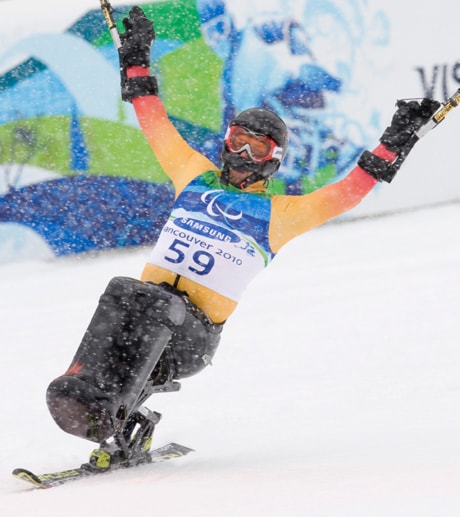WHISTLER, B.C. — Josh Dueck has one sweet ride at the Paralympics.
The sit-ski the Canadian rode to a silver medal in the alpine slalom race has been tweaked and tricked out.
It’s jet black and has enough features to make an F-1 engineer take notice.
Dueck chuckled when asked if the sit-ski, which racers call a bucket, has a name yet.
“My Little Girl,” he laughed.
But Dueck became serious when talking about the importance of the funding Paralympic athletes have received from Own The Podium.
His beloved bucket is a direct result of the program.
“The first thing they did is get me a silver medal,” said the Vernon, B.C., resident.
“There is no way that we could be where we are in terms of most, if not all the athletes on the Canadian program, without OTP. The sit-ski category would not be where we are today.”
Own the Podium is the $117-million program designed to help Canadian athletes win more medals than any other country at the Olympic Games.
The program spent money on training, medical support and new technology through its top secret project.
While the bulk of the money was aimed at Olympic athletes, Paralympians also benefited.
Blair McIntosh, chef de mission of the Canadian Paralympic team, said over the last quadrennial the Paralympic winter sports have received around $10.1 million for their national team programs.
“It’s really given our athletes an opportunity to attend more competitions than they ever have been able to,” said McIntosh.
“They’ve gotten together more as a team for training and taken advantage of the sport science side of sport.
“All of that has really helped them and it shows in their performance.”
The recent budget doubled Ottawa’s funding to OTP to $22 million. The government also promised $10 million over the next two years for the Canadian Paralympic Committee.
One of OTP’s components was the $8-million Top Secret Program.
Its role was the development of equipment and technology to give Canadian athletes an edge. Studying the right waxes for the weather and snow conditions was part of program.
Todd Allinger, manger of the Top Secret Program, said waxing and ski grinding techniques developed for the Olympics also apply to the Paralympics.
“All our top para-athletes have been through the wind tunnel in Ottawa, the same as our other athletes,” Allinger said. “They also benefit from our snow sport working group.”
Dueck’s sit-ski was designed in co-ordination with the Top Secret Program. What makes this bucket special is its ability to adapt to different disciplines and conditions.
Think of a car that could compete in F-1, NASCAR, even drag racing.
“It’s the Swiss army knife of sit-skis,” said Dueck, 29, a former freestyle skier and coach who suffered a spinal injury landing a jump in March 2004.
“It’s very competitive in downhill, super-G, giant slalom and slalom. It’s a simple adjustment where I can change a couple of little things, my centre of mass and the angle of my feet, to create a little more stability depending on the event I am doing.”
Allinger said the sit-ski can be adjusted to fit the snow and its pilot.
“Basically, it is tuned to how aggressive you can ski, so it follows the contours of the snow,” he said. “It depends on the snow conditions, if you are on hard, icy snow or softer, wet snow.”
Dueck estimates the current model would cost between $4,000 and $6,000. He hopes to refine it so it can be produced at a lower cost.
“This is the future of sit-skiing right underneath me,” he said. “It is still a prototype.
“We need a little more time and a little more money to finish this project off and make this widely available to the public. If we can do that, this will help sport in Canada but also increase the level of competition world wide.”
Allinger said Canada’s wheelchair curling team has worked with a camera and laser tracking devise to improve their deliveries.
It’s the same system Olympic gold medallist Kevin Martin trained with.
Not all the projects have been a success.
Todd Nicholson, a member of the defending gold medallist sledge hockey team, said money from OTP helped finance more trips to competitions and paid to hire extra staff.
But attempts to design new sleds and the picks players use to propel themselves on the ice had mixed results.
“We tried some different designs, a couple different sleds, some different picks,” said Nicholson. “Unfortunately we weren’t able to benefit from that side of things.”
